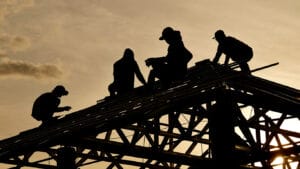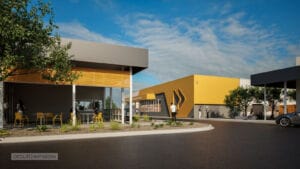Fueled by education-related projects, another new Cactus League spring training facility and Indian casinos, the construction industry in Arizona appears to be gaining footing in 2011.
Though not experiencing a full-scale rebound, contractors have reasons to be somewhat optimistic. For example, K-12 school districts around the state won voter approval in November of bond issues and budget overrides totaling more than $500M — but not all of the money is earmarked for construction or remodeling.
Contractors also anticipate increased activity in the solar energy field, thanks in part to SB 1403, approved in 2009. The law offers tax incentives for businesses locating alternative and solar energy manufacturing plants and corporate headquarters in Arizona.
Perhaps the highest-profile project that attracted numerous general contractors is the proposed spring training stadium and facilities for the Chicago Cubs in Mesa. Beth Huning, Mesa city engineer, says the city hopes to break ground on the 100-plus acre project southeast of the intersection of the Loop 101 and 202 freeways by the end of 2011. The Cubs want to use their new facility for spring training in 2013.
Mesa voters on Nov. 2 approved a ballot measure that allows the city to spend up to $84M for a new stadium, practice fields and training facilities. In addition, city officials have promised to spend no more than $15M for associated infrastructure improvements. The Cubs will be responsible for any cost overruns, and plan to build a “Wrigleyville West” entertainment and retail complex next to the baseball facilities.
Mortenson Construction, which just completed Salt River Fields at Talking Stick, the new spring training home of the Arizona Diamondbacks and Colorado Rockies at Loop 101 north of Indian Bend Road on the Salt River Pima-Maricopa Indian Community, was among the general contractors vying for the Cubs facility.
George Forristall, director of business development for Mortenson, says the firm is involved in major projects at all three state universities. He cites two Arizona State University recreation facilities — one at the Polytechnic campus in Mesa and one at the ASU West campus — each in the $17M range; a $53M Health & Learning Center at Northern Arizona University in Flagstaff that may not break ground until 2012; and an expansion of the north end zone at the University of Arizona football stadium in Tucson. The UA project, estimated at $50M, includes replacing aluminum seating with 5,000 upgraded seats, new concession concourses, additional restrooms, and elevators to improve access for the disabled.
Robert “Bo” Calbert, Southwest regional president of McCarthy Building Companies, says his firm expects to be active in public school projects, considering the success of numerous bond issues and budget overrides totaling a half-billion dollars.
“The K-12 market is a pretty big market for us,” Calbert says. “We expect to see several projects this year — not a ton compared to the last few years, but it’s a steady market.”
Among the successful school districts were Kyrene Elementary, $116.9M; Scottsdale Unified, $115M; Chandler Unified, $84.3M; Washington Elementary, $65M; and Marana Unified, $43M.
“A lot of schools will do upgrades and renovations, but not much new construction,” Calbert says. “Considering the state of the economy, it’s a fairly active market, albeit smaller than two-three years ago.”
He suggests a reason for the wave of successful bond issues: “The public has seen … state cuts in education spending. If not for bond issues, the needs of these schools would not be met.”
Many of the projects will involve heating and air-conditioning upgrades, with some schools opting for solar devices.
McCarthy, making a big push into solar, has secured one contract and was closing in on a second substantial deal, Calbert says. He sees solar, particularly in Arizona with abundant sunshine and relatively low-cost construction, as an industry for the present and future, though challenges remain for financing.
“We’re betting on it,” he says.
McCarthy is building a new hotel for the Pasqua Yaqui Tribe near Tucson and hopes to land the Navajo Nation’s proposed Twin Arrows Casino in Northern Arizona. And there is talk of a new Fort McDowell Mohave-Apache casino near Fountain Hills, Calbert says.
In addition, despite mounting local opposition, David Jones, president and CEO of the Arizona Contractors Association, says he expects the Tohono O’odham Nation to be successful in building a resort and casino adjacent to Glendale for an estimated $500M. Also in 2011, Jones sees a continuation of healthcare and hospital construction, solar projects in the Kingman and Gila Bend areas, a private prison near Prescott, mining projects southeast of Tucson and near Patagonia, and perhaps federal projects to beef-up security along the border with Mexico.
Forristall says the formation of the Arizona Commerce Authority, a public/private agency to spur economic development, is “a very positive sign.” He also praises the efforts of the Greater Phoenix Economic Council in utilizing the tools in SB 1403 to attract solar projects.
Forristall sees a gradual recovery in 2011. He says 2009 was a tough year for construction and 2010 basically maintained the status quo. “I see 2011 — not a U-shape — but I see a bit more activity, more optimism,” he says. “So we’re positive about the outlook.”



